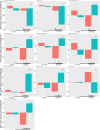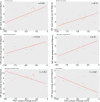Osteopathy modulates brain-heart interaction in chronic pain patients: an ASL study
- PMID: 33633195
- PMCID: PMC7907192
- DOI: 10.1038/s41598-021-83893-8
Osteopathy modulates brain-heart interaction in chronic pain patients: an ASL study
Abstract
In this study we used a combination of measures including regional cerebral blood flow (rCBF) and heart rate variability (HRV) to investigate brain-heart correlates of longitudinal baseline changes of chronic low back pain (cLBP) after osteopathic manipulative treatment (OMT). Thirty-two right-handed patients were randomised and divided into 4 weekly session of OMT (N = 16) or Sham (N = 16). Participants aged 42.3 ± 7.3 (M/F: 20/12) with cLBP (duration: 14.6 ± 8.0 m). At the end of the study, patients receiving OMT showed decreased baseline rCBF within several regions belonging to the pain matrix (left posterior insula, left anterior cingulate cortex, left thalamus), sensory regions (left superior parietal lobe), middle frontal lobe and left cuneus. Conversely, rCBF was increased in right anterior insula, bilateral striatum, left posterior cingulate cortex, right prefrontal cortex, left cerebellum and right ventroposterior lateral thalamus in the OMT group as compared with Sham. OMT showed a statistically significant negative correlation between baseline High Frequency HRV changes and rCBF changes at T2 in the left posterior insula and bilateral lentiform nucleus. The same brain regions showed a positive correlation between rCBF changes and Low Frequency HRV baseline changes at T2. These findings suggest that OMT can play a significant role in regulating brain-heart interaction mechanisms.
Conflict of interest statement
The authors declare no competing interests.
Figures





Similar articles
-
Data-driven analysis of whole-brain intrinsic connectivity in patients with chronic low back pain undergoing osteopathic manipulative treatment.Neuroimage Clin. 2024;43:103659. doi: 10.1016/j.nicl.2024.103659. Epub 2024 Aug 22. Neuroimage Clin. 2024. PMID: 39208480 Free PMC article. Clinical Trial.
-
Acute changes in functional connectivity associated with first osteopathic manual treatment in chronic low back pain spatially overlap with opioid receptor expression.Brain Res Bull. 2025 Jun 15;226:111375. doi: 10.1016/j.brainresbull.2025.111375. Epub 2025 May 11. Brain Res Bull. 2025. PMID: 40360075
-
Functional imaging of brain responses to pain. A review and meta-analysis (2000).Neurophysiol Clin. 2000 Oct;30(5):263-88. doi: 10.1016/s0987-7053(00)00227-6. Neurophysiol Clin. 2000. PMID: 11126640 Review.
-
Opposite effects of high and low frequency rTMS on regional brain activity in depressed patients.Biol Psychiatry. 2000 Dec 15;48(12):1133-41. doi: 10.1016/s0006-3223(00)01065-9. Biol Psychiatry. 2000. PMID: 11137053 Clinical Trial.
-
Understanding anesthesia through functional imaging.Curr Opin Anaesthesiol. 2008 Oct;21(5):530-6. doi: 10.1097/ACO.0b013e32830edbf3. Curr Opin Anaesthesiol. 2008. PMID: 18784475 Review.
Cited by
-
Effectiveness of Osteopathic Manipulative Treatment in Adults with Irritable Bowel Syndrome: A Systematic Review and Meta-Analysis.Healthcare (Basel). 2023 Aug 31;11(17):2442. doi: 10.3390/healthcare11172442. Healthcare (Basel). 2023. PMID: 37685480 Free PMC article. Review.
-
Osteopathic health care in aged care facilities: The experience of practitioners in an emerging practice setting.Australas J Ageing. 2024 Dec;43(4):828-836. doi: 10.1111/ajag.13362. Epub 2024 Aug 19. Australas J Ageing. 2024. PMID: 39158117 Free PMC article.
-
Beliefs and Use of Palpatory Findings in Osteopathic Clinical Practice: A Qualitative Descriptive Study among Italian Osteopaths.Healthcare (Basel). 2022 Aug 29;10(9):1647. doi: 10.3390/healthcare10091647. Healthcare (Basel). 2022. PMID: 36141259 Free PMC article.
-
Modifying functional brain networks in focal epilepsy by manual visceral-osteopathic stimulation of the vagus nerve at the abdomen.Front Netw Physiol. 2023 Jul 13;3:1205476. doi: 10.3389/fnetp.2023.1205476. eCollection 2023. Front Netw Physiol. 2023. PMID: 37520657 Free PMC article.
-
Neurobiological substrates of chronic low back pain (CLBP): a brain [99mTc]Tc-ECD SPECT study.Eur J Hybrid Imaging. 2022 Nov 21;6(1):26. doi: 10.1186/s41824-022-00145-2. Eur J Hybrid Imaging. 2022. PMID: 36404393 Free PMC article.
References
MeSH terms
LinkOut - more resources
Full Text Sources
Other Literature Sources
Medical

